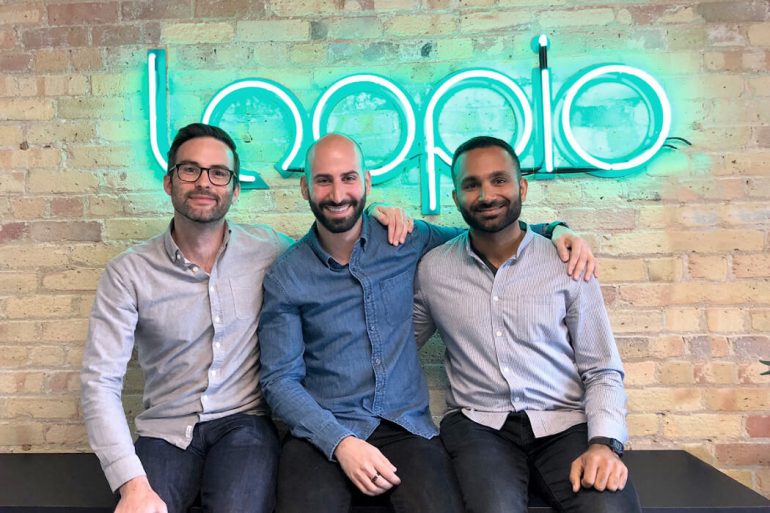In April, Toronto-based B2B software startup Loopio closed a $252 million CAD strategic investment, its second external fundraise since being founded seven years ago.
The $252 million deal was one of the most significant private Canadian tech investments closed in the month of April, and marked a significant stage in Loopio’s journey. Over the last seven years, the startup has grown from a bootstrapped team of three workers to a 180-strong company boasting over 1,000 customers.
But Loopio did not take the typical fundraising path of a B2B SaaS startup. BetaKit spoke with Loopio co-founder and CEO Zak Hemraj about Loopio’s road to $252 million, and what the startup’s next chapter holds.
Bootstrapped beginnings
Loopio sells software to businesses that bid for contracts from other organizations, often larger enterprises and governments. Loopio’s product was designed to help these businesses simplify and automate the work that goes behind request-for-proposals (RFP). Loopio provides RFP response software to organizations across many industries, including healthcare, financial services, and telecommunications.
“We didn’t really think about [bootstrapping] in the beginning; we just started building.”
The startup was founded in 2014 by Hemraj, CTO Matt York, and board member Jafar Owainati. Owainati has previously served as COO and CRO of the company, but recently transitioned to a board member role to found a software startup called Barley.
Before creating Loopio, all three founders struggled throughout their careers with the tasks required to answer RFPs, a process Hemraj described as manual, repetitive, and time-consuming. Previously connected through either work or university, the trio began devising a new way to make the RFP response process more efficient from start to finish.
For the first three years of Loopio’s existence, the priority was building the foundation for the company. The founders developed the first version of the product, rolled out a free beta version, assembled a team of approximately 25 employees, and onboarded Loopio’s earliest customers, all with no venture backing.
“We didn’t really think about [bootstrapping] in the beginning; we just started building,” said Hemraj. “And then, about a year into our journey, as we started to get some cash flow and started to close in customers, it became clear that we [could] bootstrap this thing.”
Hemraj said the decision to bootstrap ultimately allowed Loopio’s co-founders to achieve scale while maintaining control in the company. Owainati has also said bootstrapping forced the founders to be nimble and stay focused on their customers’ pain points.
Closing the first round
By 2017, Loopio had built its product and grown its customer base to over 300 organizations. Hemraj said many of these customers began discussing Loopio with their own investors.
As a result, Loopio saw a great deal of inbound interest from VCs. This interest, paired with the fact that Loopio was achieving scale in the market, made the timing right to raise a first external round of financing.

“That’s the best time to fundraise, when you don’t need the money,” Hemraj said. “And that was our situation.”
The startup secured $9 million USD in Series A funding in early 2018. OpenView, which bills itself as an “expansion stage” venture firm, led the round. Following the deal, Loopio continued to scale its product and grow its sales pipeline.
“As we started to zoom out a little bit and hire more of a team, it became clear just how big the market opportunity was,” he said. “There were other use cases for Loopio, there were all different types of companies that were out there, and we had the opportunity to hit the gas.”
Facing down the pandemic
Over the next three years, Loopio continued developing its product, and expanding its team and customer base. The startup had built automation and reporting tools within its platform and launched integrations with software such as Slack and Google Chrome. By 2020, the software had been used by more than 750 organizations, and Hemraj said the startup had built a “very predictable” sales flow.
Then, in the spring of 2020, the COVID-19 pandemic hit Canada. Like many industries, the world of RFP management changed dramatically. An industry pulse check survey conducted by Loopio in April found that approximately one-third of RFP respondents saw a decrease in the volume of RFPs they were receiving. This downturn also impacted Loopio.
“The majority of our sales pipeline was just cut, it just evaporated,” Hemraj said. “A lot of these businesses that we spoke to weren’t going to evaluate new software purchases at that time.”
Due to uncertainty around the duration and severity of the pandemic, the startup entered a new mindset: protect cash. In May, Loopio temporarily scaled back its go-to-market strategy to adapt to the business environment. As a result, the startup laid off 11 team members, which represented eight percent of the company at the time.
RELATED: Loopio secures $252 million to accelerate its growth in RFP software market
This chapter of Loopio’s journey is similar to what many Canadian tech companies faced during the COVID-19 pandemic. According to an April 2020 study from Startup Genome, 58 percent of startups in Canada said their industry had been “affected significantly” by the COVID-19 crisis, which was seven percentage points higher than the global average. However, Hemraj told BetaKit in May that he believed the slowdown would be temporary.
Loopio continued to be fully operational during the pandemic. Even when the startup’s sales were affected, Hemraj claimed Loopio’s customer retention had been better in Q1 2020 than in the previous year.
COVID-19 accelerated the digital transformation of virtually every industry, from retail to healthcare, to education. Hemraj said this rapid disruption allowed Loopio to make the most of the changing market.
“We started to see things come back to life in Q2 and Q3,” Hemraj said. “By the fall, [the business] definitely rebounded.”
The biggest milestone
Hemraj attributed Loopio’s ability to rebound after the initial shockwave of the pandemic to several factors. The first, he said, is the resilience of the market Loopio is operating in. Because Loopio does not target one specific sector, the pandemic allowed the startup to calibrate and determine which industries to target and how the team could amplify Loopio’s business.
“We saw RFP response wasn’t going anywhere. If anything, the market got bigger.”
“We saw RFP response wasn’t going anywhere. If anything, the market got bigger,” the CEO added. “[It was] still very under-penetrated, and just like three and a half years ago, competition was starting to increase, and we are definitely in a leadership position in our market, and we didn’t want that to go away.”
The CEO also attributed Loopio’s success during the pandemic to the team’s resilience, as well as Loopio’s enterprise segment, where the company is now achieving gross retention in the mid – 90’s and 120 percent net retention.
Hemraj also pointed to the significant volume of transactions occurring in Canadian tech since the end of 2020, driven by a “pent up demand” from investors.
“We caught wind of this, and our network made it very clear that the timing was right,” he said.

In April, Sumeru Equity Partners and Affiliates (SEP) acquired a stake in Loopio for $252 million CAD. OpenView, Loopio’s previous investor, was bought out in the transaction. The portion of equity acquired by Sumeru was not disclosed, however, Sumeru told The Globe and Mail it typically purchases majority stakes when it invests.
Hemraj has described the $252 million investment as the biggest milestone in Loopio’s history. He told BetaKit that in selecting Sumeru as its investor, the company decided to go with the best financial outcome, but more importantly, a partner that could support Loopio for the years to come.
Loopio’s next chapter
With the funding, Loopio is now in the next chapter of its growth. The company generates roughly $20 million in annual recurring revenue and has grown its revenues six-fold since raising its Series A round of funding.
The team’s focus is accelerating product development and extending the deployment of its platform in global markets. Though the platform already counts many international organizations among its customers, Hemraj said the startup is looking to advance deeper into English-speaking countries, such as the United Kingdom and Australia.
RELATED: How Ada piggybacked Zoom and Shopify’s growth during the pandemic to become a Canadian unicorn
Loopio also plans to grow to more than 200 employees by the end of this year, and hire in both Toronto and the United States. Since shifting to remote work in 2020, Loopio has worked to maintain a sense of employee connection through various engagement programs. The startup was recently named among Canada’s top small and medium employers for 2021.
Looking ahead, Hemraj believes Loopio has the opportunity to be a Canadian success story that not only wins in its category, but also generates the next cohort of Canadian startups.
“We have a massive market in RFP response and general sales enablement that is not that heavily penetrated,” Hemraj said. “We have this window here where we can truly win in our category and become a meaningful global business.”
Feature image courtesy of Loopio.
With files from Meagan Simpson.


